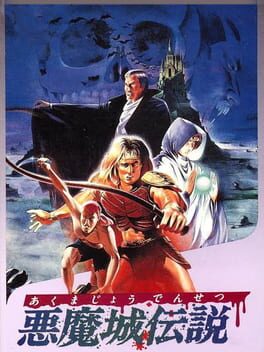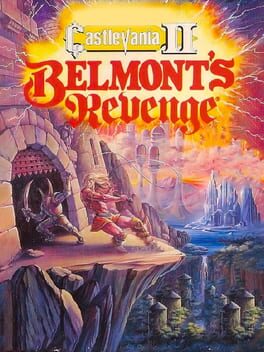

Akumajou Densetsu is the Japanese version of Castlevania III: Dracula's Curse. This version has many differences in gameplay and level layout, making the overall experience easier than its western counterpart.
Also in series
Reviews View More
Played with Sypha
Perhaps the most existential and searching of this original trilogy, Castlevania 3 feels so discontent with the idea of stable identity that it introduces four new playable characters to the fold. When you jump in either direction as Trevor, if you switch to your secondary character in mid-air, the virtual momentum is carried through them as they carve the rest of his arc across the screen. There is no locomotive difference in such an instant, your two characters of choice moving seamlessly as one. As these confused personalities splinter and reconvene amongst themselves, the mood fluctuates more dynamically than it did in either of the prior games, wandering between the propulsive mania of the original title and the melancholic yearning of its sequel. While this game is historically heralded as a “return to form” after the botched excursion of Simon’s Quest, there are so many more variables at play here than there were in Castlevania. That game’s form was one of consistency, a minimal rule set that is barebones, but transparent and unwavering too. There’s so much more bouncing around here. Is this level easier or more fun if I play as Trevor, or if I play as Grant, or if I play as Alucard, or I suppose if I play as Alucard maybe I should just use his bat form, or maybe I should play as Sypha, but then if I play as Sypha which of my three possible spells is best suited to this situation..? I would argue this has more in common with Simon’s Quest’s baggier formal qualities, similarly experimental in that it’s just kind of throwing shit in there to see what sticks but not to so radical an end.
In Castlevania, Simon is stiff, hard as a rock. Here, Trevor feels the tethers slip as he invites others along for the ride. This game is too insecure, too impulsive for the original's level of commitment. This isn’t to say that it’s impotent, there’s a great deal of sweat to gleefully shed and outbursts to compulsively voice here. Rather, it seems keen on continually checking in on you throughout the affair, to the point that the form starts to feel decidedly less content with itself. The second stage is a clocktower adorned with turning gears and swinging pendulums, the routine of linear time gamified through cyclicality. It’s an inventive use of digital space and aesthetics, and at the end of it you can recruit Grant to your team. Now, you make your way backwards through the very same level with a new set of limbs through which to traverse it. Where the first game silently shares in your enthused sense of discovery, this game points knowingly at the mechanics of its own construction. But ultimately, I’ve just already been here before and I don’t really want to do the whole thing again, even with this freaky little dude who can climb into all sorts of unexpected crevices.
I previously said that Castlevania 2 left “no room for growth outside of circumstance, no room for excess,” but the more that I consider that point, the less satisfied I am with my specificity there. Castlevania 2 is actually an extremely excessive game – it has excess game, at the expense of play. There’s so much game, so many mechanical loose ends and extraneous systems and items that the game seems so much more cryptic than it really is, preventing imaginative engagement with the work by mandating a deconstructive understanding of which systems are relevant in which scenarios to simply complete it. At this point there is very little play, because we need to make so much room for game. Castlevania 3 has a similar excess of game, but because all of this game is equally viable throughout (though certainly not equally effective or efficient), it feels more like an invitation to just fuck around. To play. When I discovered that Sypha can freeze water, I gasped. It felt so awesome to stumble upon that revelation unprompted, and I was astounded that it worked. But now, I can’t help but wonder, to what end? Sure, that is a remarkable little work of design but, again, it’s excess. It didn’t really have to be there. In some sense that makes it more special. In another, why am I not just flying around as Alucard again..?
The audiovisual excesses tickle me a lot more. It’s all so baroque, the soundtrack endlessly fractal in its embellishments, the graphics unbelievably lurid and suggestive. In these spaces, your imagination is once more invited into the fold. Stage 3 in particular has some sort of swirling starry water that I honestly don’t even understand on the level of representation, I guess it could be a river but I’m really not sure. Regardless, my delight at discovering something like Sypha’s water-freezing capabilities was ultimately diminished by – sorry folks – how brutally fucking difficult this game was. I have no desire to play the American release after this. I just wanted to get through it by the end. I understand this game has this reputation and there’s some sort of ongoing dialogue about its validity but, for me, it eventually devolves into levels of slog I wouldn’t even accuse Simon’s Quest of. I’m sure on replays this issue is lessened by virtue of familiarity but I’m not sure I’ll ever get to that point so I’m just working with what I got from this playthrough for now. I found that this game demands a level of perfection that the original encouraged. You could reasonably scrape by through the majority of Castlevania, but the stages here are just too lengthy, too full of enemies that will decimate your health pool as punishment for any and every error, no matter how slight. When there aren’t enemies, there are long, twisted bouts of platforming that demand the counterintuitive precision of timing a jump at the exact moment you think Trevor would fall off a ledge. Swapping my brain back and forth between these modes of play is consistently more difficult than I expect it to be. Just when I’ve gotten the hang of one screen, the next requires a style of play I’d just dumped in favor of mastering the other. It’s a skill issue to be sure. But if the original game requires sheer dedication to forward progress and the second requires a dedication to wandering, this third installment demands something more solemn and reverent. It asks you to quiet yourself and focus. It asks you to slow down and believe. It asks you if you’re frightened as it continually rips itself apart and reconfigures itself before your very eyes. It asks you if you want to share in the joy of becoming multiple. It’s a daunting thing.
Perhaps the most existential and searching of this original trilogy, Castlevania 3 feels so discontent with the idea of stable identity that it introduces four new playable characters to the fold. When you jump in either direction as Trevor, if you switch to your secondary character in mid-air, the virtual momentum is carried through them as they carve the rest of his arc across the screen. There is no locomotive difference in such an instant, your two characters of choice moving seamlessly as one. As these confused personalities splinter and reconvene amongst themselves, the mood fluctuates more dynamically than it did in either of the prior games, wandering between the propulsive mania of the original title and the melancholic yearning of its sequel. While this game is historically heralded as a “return to form” after the botched excursion of Simon’s Quest, there are so many more variables at play here than there were in Castlevania. That game’s form was one of consistency, a minimal rule set that is barebones, but transparent and unwavering too. There’s so much more bouncing around here. Is this level easier or more fun if I play as Trevor, or if I play as Grant, or if I play as Alucard, or I suppose if I play as Alucard maybe I should just use his bat form, or maybe I should play as Sypha, but then if I play as Sypha which of my three possible spells is best suited to this situation..? I would argue this has more in common with Simon’s Quest’s baggier formal qualities, similarly experimental in that it’s just kind of throwing shit in there to see what sticks but not to so radical an end.
In Castlevania, Simon is stiff, hard as a rock. Here, Trevor feels the tethers slip as he invites others along for the ride. This game is too insecure, too impulsive for the original's level of commitment. This isn’t to say that it’s impotent, there’s a great deal of sweat to gleefully shed and outbursts to compulsively voice here. Rather, it seems keen on continually checking in on you throughout the affair, to the point that the form starts to feel decidedly less content with itself. The second stage is a clocktower adorned with turning gears and swinging pendulums, the routine of linear time gamified through cyclicality. It’s an inventive use of digital space and aesthetics, and at the end of it you can recruit Grant to your team. Now, you make your way backwards through the very same level with a new set of limbs through which to traverse it. Where the first game silently shares in your enthused sense of discovery, this game points knowingly at the mechanics of its own construction. But ultimately, I’ve just already been here before and I don’t really want to do the whole thing again, even with this freaky little dude who can climb into all sorts of unexpected crevices.
I previously said that Castlevania 2 left “no room for growth outside of circumstance, no room for excess,” but the more that I consider that point, the less satisfied I am with my specificity there. Castlevania 2 is actually an extremely excessive game – it has excess game, at the expense of play. There’s so much game, so many mechanical loose ends and extraneous systems and items that the game seems so much more cryptic than it really is, preventing imaginative engagement with the work by mandating a deconstructive understanding of which systems are relevant in which scenarios to simply complete it. At this point there is very little play, because we need to make so much room for game. Castlevania 3 has a similar excess of game, but because all of this game is equally viable throughout (though certainly not equally effective or efficient), it feels more like an invitation to just fuck around. To play. When I discovered that Sypha can freeze water, I gasped. It felt so awesome to stumble upon that revelation unprompted, and I was astounded that it worked. But now, I can’t help but wonder, to what end? Sure, that is a remarkable little work of design but, again, it’s excess. It didn’t really have to be there. In some sense that makes it more special. In another, why am I not just flying around as Alucard again..?
The audiovisual excesses tickle me a lot more. It’s all so baroque, the soundtrack endlessly fractal in its embellishments, the graphics unbelievably lurid and suggestive. In these spaces, your imagination is once more invited into the fold. Stage 3 in particular has some sort of swirling starry water that I honestly don’t even understand on the level of representation, I guess it could be a river but I’m really not sure. Regardless, my delight at discovering something like Sypha’s water-freezing capabilities was ultimately diminished by – sorry folks – how brutally fucking difficult this game was. I have no desire to play the American release after this. I just wanted to get through it by the end. I understand this game has this reputation and there’s some sort of ongoing dialogue about its validity but, for me, it eventually devolves into levels of slog I wouldn’t even accuse Simon’s Quest of. I’m sure on replays this issue is lessened by virtue of familiarity but I’m not sure I’ll ever get to that point so I’m just working with what I got from this playthrough for now. I found that this game demands a level of perfection that the original encouraged. You could reasonably scrape by through the majority of Castlevania, but the stages here are just too lengthy, too full of enemies that will decimate your health pool as punishment for any and every error, no matter how slight. When there aren’t enemies, there are long, twisted bouts of platforming that demand the counterintuitive precision of timing a jump at the exact moment you think Trevor would fall off a ledge. Swapping my brain back and forth between these modes of play is consistently more difficult than I expect it to be. Just when I’ve gotten the hang of one screen, the next requires a style of play I’d just dumped in favor of mastering the other. It’s a skill issue to be sure. But if the original game requires sheer dedication to forward progress and the second requires a dedication to wandering, this third installment demands something more solemn and reverent. It asks you to quiet yourself and focus. It asks you to slow down and believe. It asks you if you’re frightened as it continually rips itself apart and reconfigures itself before your very eyes. It asks you if you want to share in the joy of becoming multiple. It’s a daunting thing.
This was easier than the USA version but it was still pretty difficult I have only ever beat this twice now since I beat this Japanese version. I used to think that Draculas 3rd phase was impossible then I learned how to melt him with Sypha's magic another thing is I have tried most of the branching paths and I find the top route through the woods that leads to the ghost ship is the easiest way, the only reason to take the lower path would be if you want to get Alucard I prefer Sypha myself and I have never played as Grant much because I hate the clock tower anyway this is a great game.





